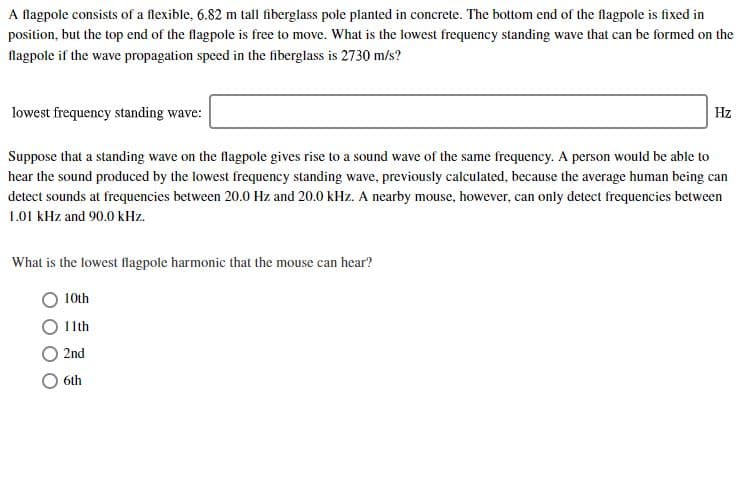A flagpole consists of a flexible, 6.82 m tall fiberglass pole planted in concrete. The bottom end of the flagpole is fixed in position, but the top end of the flagpole is free to move. What is the lowest frequency standing wave that can be formed on the flagpole if the wave propagation speed in the fiberglass is 2730 m/s? lowest frequency standing wave: Hz Suppose that a standing wave on the flagpole gives rise to a sound wave of the same frequency. A person would be able to hear the sound produced by the lowest frequency standing wave, previously calculated, because the average human being can detect sounds at frequencies between 20.0 Hz and 20.0 kHz. A nearby mouse, however, can only detect frequencies between 01 kHz and 90.0 kHz What is the lowest flagpole harmonic that the mouse can hear? 10th 11th 2nd 6th
A flagpole consists of a flexible, 6.82 m tall fiberglass pole planted in concrete. The bottom end of the flagpole is fixed in position, but the top end of the flagpole is free to move. What is the lowest frequency standing wave that can be formed on the flagpole if the wave propagation speed in the fiberglass is 2730 m/s? lowest frequency standing wave: Hz Suppose that a standing wave on the flagpole gives rise to a sound wave of the same frequency. A person would be able to hear the sound produced by the lowest frequency standing wave, previously calculated, because the average human being can detect sounds at frequencies between 20.0 Hz and 20.0 kHz. A nearby mouse, however, can only detect frequencies between 01 kHz and 90.0 kHz What is the lowest flagpole harmonic that the mouse can hear? 10th 11th 2nd 6th
Physics for Scientists and Engineers: Foundations and Connections
1st Edition
ISBN:9781133939146
Author:Katz, Debora M.
Publisher:Katz, Debora M.
Chapter17: Traveling Waves
Section: Chapter Questions
Problem 14PQ
Related questions
Question

Transcribed Image Text:A flagpole consists of a flexible, 6.82 m tall fiberglass pole planted in concrete. The bottom end of the flagpole is fixed in
position, but the top end of the flagpole is free to move. What is the lowest frequency standing wave that can be formed on the
flagpole if the wave propagation speed in the fiberglass is 2730 m/s?
lowest frequency standing wave:
Hz
Suppose that a standing wave on the flagpole gives rise to a sound wave of the same frequency. A person would be able to
hear the sound produced by the lowest frequency standing wave, previously calculated, because the average human being can
detect sounds at frequencies between 20.0 Hz and 20.0 kHz. A nearby mouse, however, can only detect frequencies between
01 kHz and 90.0 kHz
What is the lowest flagpole harmonic that the mouse can hear?
10th
11th
2nd
6th
Expert Solution
This question has been solved!
Explore an expertly crafted, step-by-step solution for a thorough understanding of key concepts.
This is a popular solution!
Trending now
This is a popular solution!
Step by step
Solved in 8 steps with 8 images

Recommended textbooks for you

Physics for Scientists and Engineers: Foundations…
Physics
ISBN:
9781133939146
Author:
Katz, Debora M.
Publisher:
Cengage Learning

Principles of Physics: A Calculus-Based Text
Physics
ISBN:
9781133104261
Author:
Raymond A. Serway, John W. Jewett
Publisher:
Cengage Learning

University Physics Volume 1
Physics
ISBN:
9781938168277
Author:
William Moebs, Samuel J. Ling, Jeff Sanny
Publisher:
OpenStax - Rice University

Physics for Scientists and Engineers: Foundations…
Physics
ISBN:
9781133939146
Author:
Katz, Debora M.
Publisher:
Cengage Learning

Principles of Physics: A Calculus-Based Text
Physics
ISBN:
9781133104261
Author:
Raymond A. Serway, John W. Jewett
Publisher:
Cengage Learning

University Physics Volume 1
Physics
ISBN:
9781938168277
Author:
William Moebs, Samuel J. Ling, Jeff Sanny
Publisher:
OpenStax - Rice University